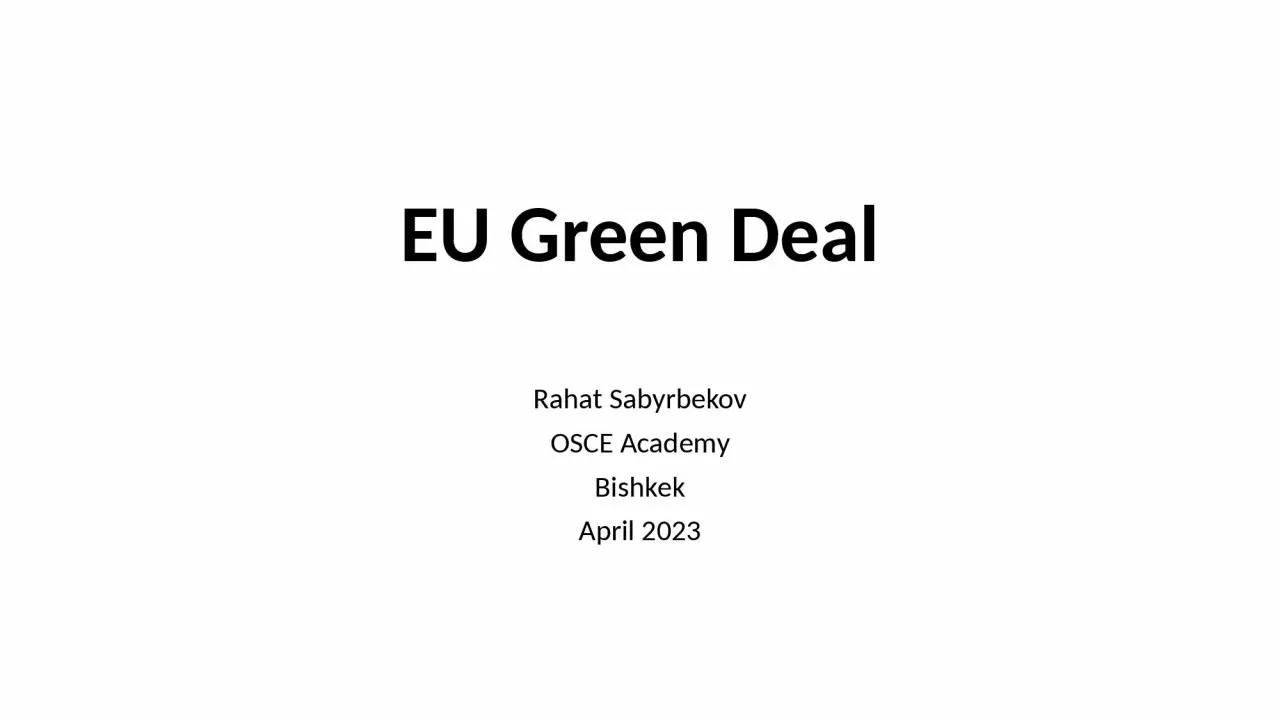

OSCE Academy Bishkek April 2023 Communication from the Commission to the European Parliament the European Council the Council the European Economic and Social Committee and the Committee of the Regions the European Green Deal 2019 ID: 1029112
Download Presentation The PPT/PDF document "EU Green Deal Rahat Sabyrbekov" is the property of its rightful owner. Permission is granted to download and print the materials on this web site for personal, non-commercial use only, and to display it on your personal computer provided you do not modify the materials and that you retain all copyright notices contained in the materials. By downloading content from our website, you accept the terms of this agreement.
1. EU Green DealRahat SabyrbekovOSCE AcademyBishkekApril 2023
2. Communication from the Commission to the European Parliament, the European Council, the Council, the European Economic and Social Committee and the Committee of the Regions the European Green Deal, 2019‘a new growth strategy that aims to transform the EU into a fair and prosperous society, with a modern, resource-efficient and competitive economy where there are no net emissions of greenhouse gases in 2050 and where economic growth is decoupled from resource use’ EU Commission, 2019
3. Introduction EU Green Deal is a roadmap for sustainable growth and development in the European UnionAims to make Europe the first climate-neutral continent by 2050Launched in December 2019 by the European CommissionDesigned to tackle climate change, biodiversity loss, and environmental pollution
4.
5. Key ObjectivesCut greenhouse gas emissions by at least 55% by 2030clear vision of how to achieve climate neutrality by 2050Transform the EU economy to be more sustainableShift to a circular economy that reduces waste and promotes recyclingIncrease energy efficiency and boost renewable energy useProtect and restore biodiversity and natural habitats
6. EU Green Deal parts
7. Designing a set of deeply transformative policiesIncreasing the EU’s climate ambition for 2030 and 2050Supplying clean, affordable and secure energyMobilising industry for a clean and circular economyBuilding and renovating in an energy and resource efficient wayAccelerating the shift to sustainable and smart mobilityFrom ‘Farm to Fork’: designing a fair, healthy and environmentally-friendly food systemPreserving and restoring ecosystems and biodiversity
8. Mainstreaming sustainability in all EU policiesPursuing green finance and investment and ensuring a just transitionGreening national budgets and sending the right price signalsMobilising research and fostering innovationActivating education and trainingA green oath: ‘do no harm’
9. Actions TakenProposing a European Climate Law to make the 2050 climate neutrality target legally bindingInvesting in research and innovation to develop sustainable technologiesImplementing a Circular Economy Action Plan to reduce waste and promote sustainable consumptionLaunching the Farm to Fork Strategy to ensure a fair, healthy and environmentally-friendly food systemProviding financial support to member states to facilitate the transition to a greener economy
10. BenefitsCreate new jobs and business opportunities in sustainable sectorsReduce pollution and improve air and water qualityProtect and restore natural habitats and biodiversityPromote sustainable and healthy food systemsEnhance Europe's leadership role in the global fight against climate change
11. ChallengesAchieving the 55% emissions reduction target by 2030 will require significant efforts and investmentsBalancing environmental and economic interestsEnsuring a just transition that supports affected communities and workersOvercoming resistance from member states and industry sectorsMaintaining public support and engagement for the EU Green Deal agenda.
12. THE EU AS A GLOBAL LEADERThe EU will continue to promote and implement ambitious environment, climate and energy policies across the world.The EU will continue to ensure that the Paris Agreement remains the indispensable multilateral framework for tackling climate change.The EU will continue to ensure that the Paris Agreement remains the indispensable multilateral framework for tackling climate change.Trade policy can support the EU’s ecological transition.As the world’s largest single market, the EU can set standards that apply across global value chains.
13. Siddi, Marco. "The European Green Deal: Assessing its current state and future implementation." (2020).
14. Policy priorityMaintaining priority in EU and national policy planning throughout the long period over which it will be implemented is the main overarching challenge for the Green Deal.COVID-19 shifted the policy focus *Russian war in Ukraine accelerated the energy transition
15. Financial endowmentThe Commission has estimated that achieving the current 2030 climate and energy targets will require €260 billion in additional annual investment.However, the actual need is much higherOverall, based on the figures and estimates that the Commission has published and the broader economic context, financial prospects for the Green Deal are not encouraging.
16. Competence of EU institutionsMost likely, member states will be reluctant to relinquish additional sovereignty on decisions that affect the structure of their energy supply and the speed and cost of the energy transition.Based on past experience, some members will probably pursue more ambitious goals than those set at EU level, while others will be less ambitious – with potential variations within each member state based on the political priorities of successive national governments.This suggests that the Commission’s proposal to use delegated acts in pursuit of climate neutrality will face strong resistance from an informal coalition of EU members that are sceptical of or oppose the 2050 target
17. International cooperationParticular emphasis is put on supporting the ecological transition in the EU’s immediate neighbours, namely the Western Balkans, the Southern Neighbourhood and the Eastern Partnership countries.While not explicitly mentioned in the Green Deal Communication, the success of global climate action will largely depend on policy coordination between the three largest GHG emitters – China, the United States and the EUCoordination with third countries will also be important in the light of measures that will need to be introduced to ensure domestic functioning and to advance the objectives of the Green Deal.
18. ConclusionThe European Commission is continuing to pursue climate action in a challenging international setting, amidst growing geopolitical tensions, the rise to power of climate change deniers in major emitters, a pandemic and the ensuing economic slowdown.Most likely more financial resources will be requiredIt can also make a fundamental contribution to climate action through technology and financial transfers to countries of the Global South
19. Thank you! Question?r.sabyrbekov@osce-academy.net